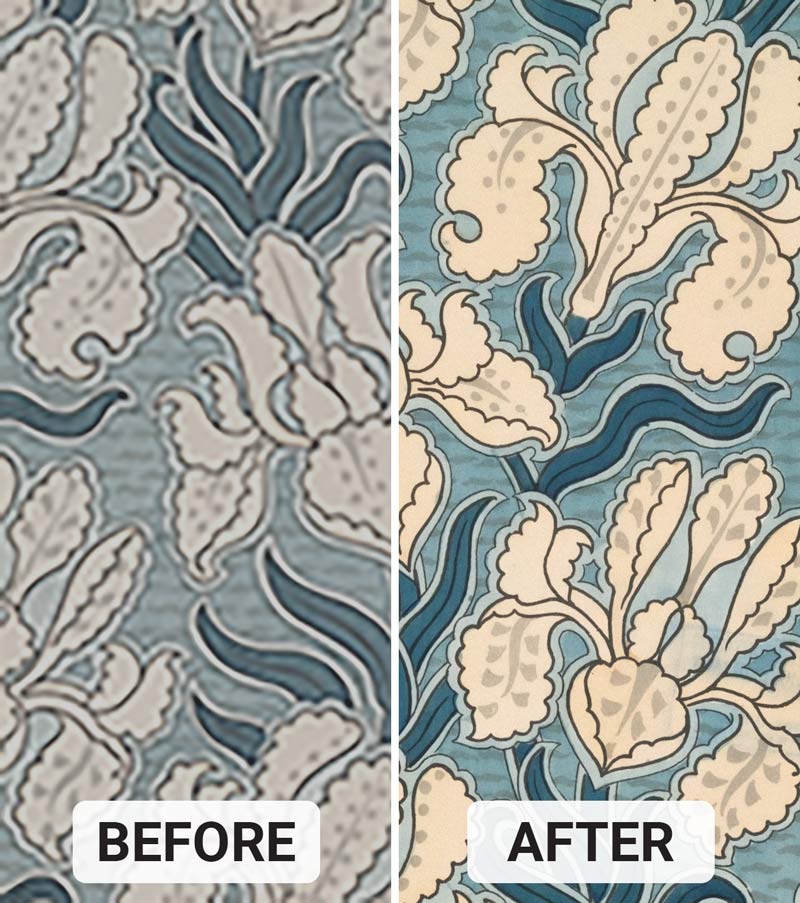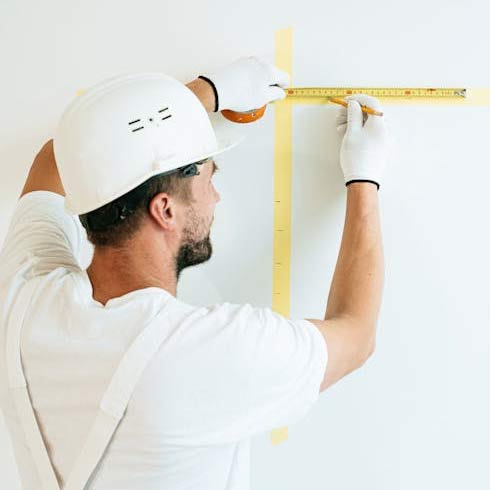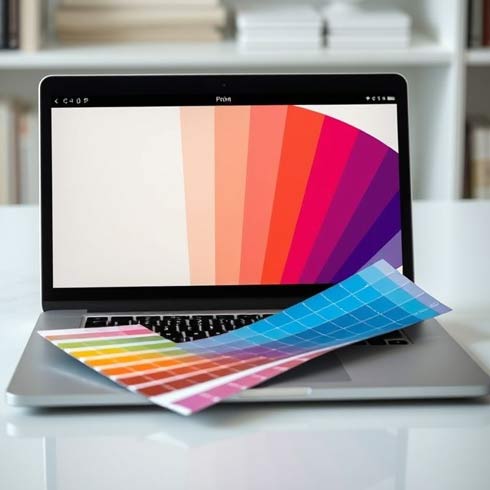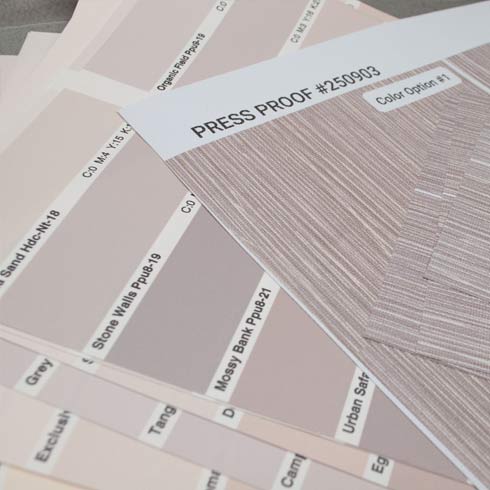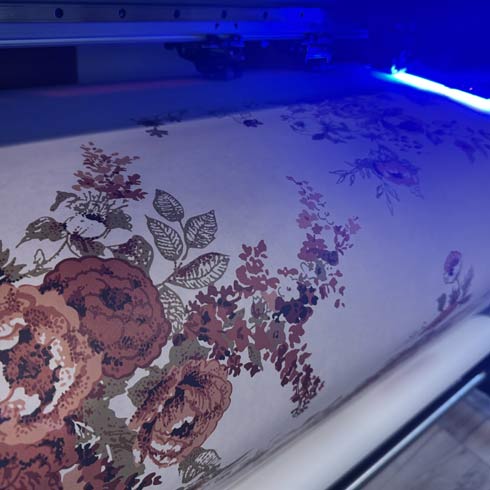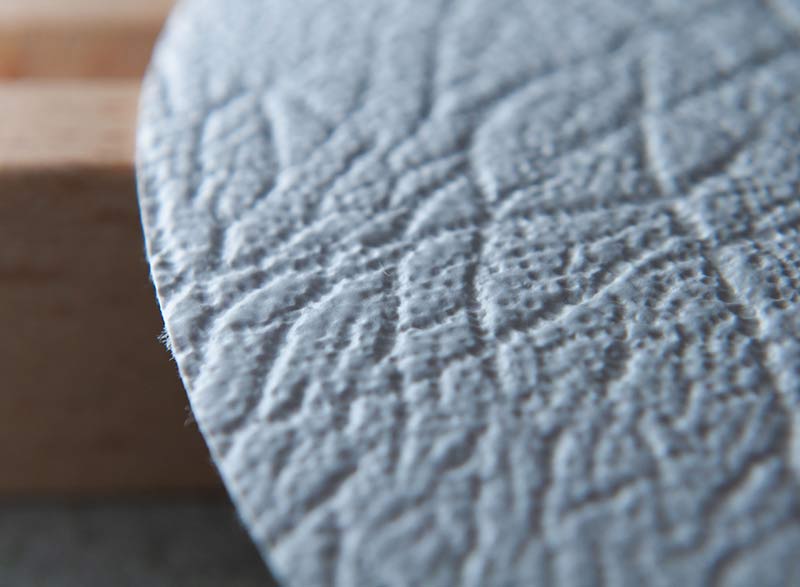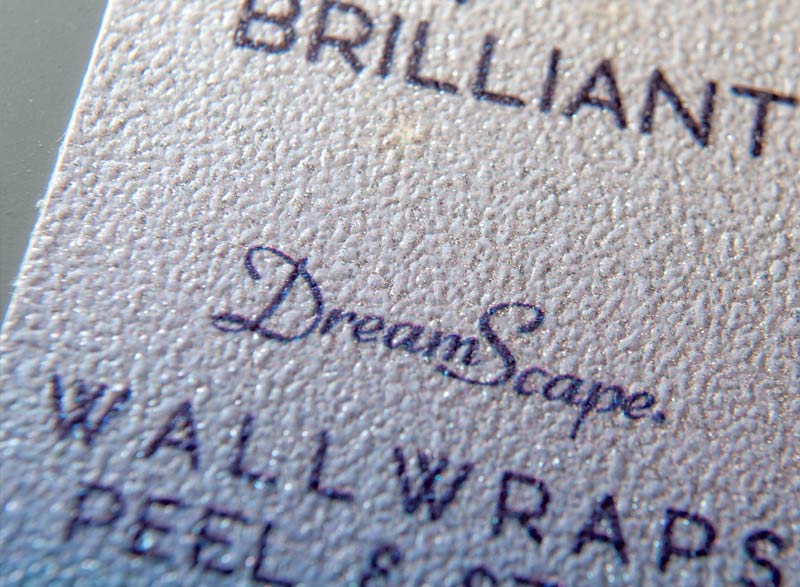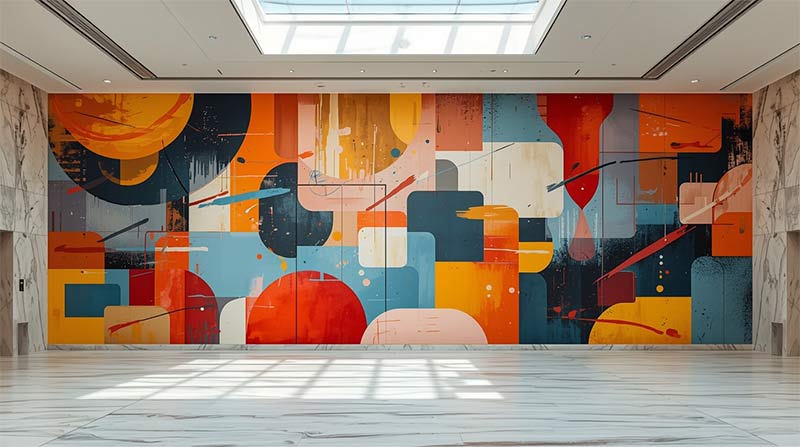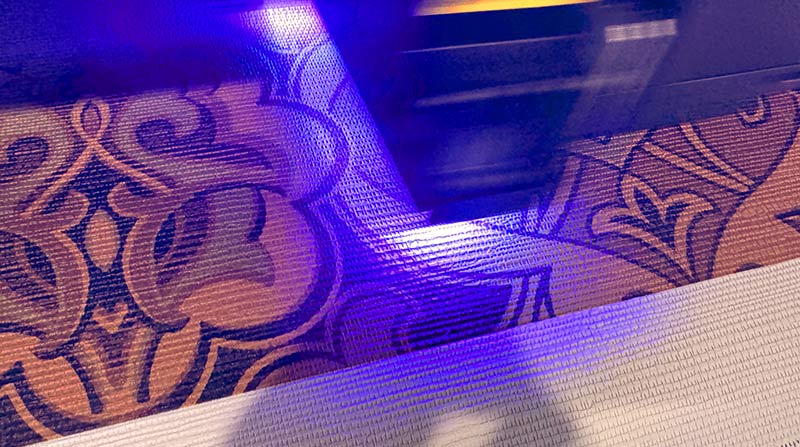Basic Questions
What is custom wallpaper printing?
Custom wallpaper printing transforms your digital artwork, photographs, or designs into high-quality wallcoverings using advanced large format printing technology.
Unlike mass-produced patterns, custom wallpaper allows you to create unique wall decor tailored to your vision and space. We use professional-grade UV inks and commercial materials to achieve museum-quality results while remaining affordable.
Whether printing family photos, brand logos, artistic murals, or custom patterns, we can turn virtually any digital image into durable, ready-to-install wallpaper.
What do I need to get started?
Begin by sharing your digital artwork or design files. Screenshots are fine for a quick check, but full files via cloud storage services (Dropbox, Google Drive, WeTransfer, OneDrive, iCloud) give the best results.
We also need your wall measurements to calculate pricing and plan panel layout across rolls. If your images are low-resolution or you need design assistance, our team can enhance images or provide creative guidance to ensure your project exceeds expectations.
Sharing details about your vision, timeline, and installation plans helps us serve you more efficiently.
Can you print any image or design?
We can print virtually any digital design using our CMYK printing process, producing vibrant, accurate colors for photographs, artwork, logos, patterns, and graphics.
Our 1200 DPI printing capability captures fine detail for exceptional clarity. We cannot replicate embossed textures or metallic finishes since our process uses UV-cured inks. Metallic elements can be simulated with metallic colors. Our color matching capabilities include over 20,000 color references to ensure your wallpaper matches your intended aesthetic.
How do I know if my project is a good fit?
Your project is ideal for custom wallpaper printing if your artwork is print-ready and you have a clear vision for the final result. Perfect candidates include homeowners wanting personalized wall art, restaurant owners creating branded environments, and property managers updating common areas.
Custom wallpaper works best for accent walls, feature installations, small business branding, or residential design projects. It offers unique design flexibility and cost-effectiveness compared to other wall treatments. Our process works best when timelines are realistic and you’re ready to collaborate for professional results.
Do you work with homeowners or just businesses?
We serve everyone—from individual homeowners and DIY enthusiasts to small businesses, restaurants, boutique hotels, Airbnb property owners, house flippers, and property management companies.
Our scalable production capabilities handle projects from single accent walls to multi-location installations. We maintain bulk material inventory and offer volume discounts, making professional custom wallpaper accessible to anyone with a creative vision.
File Requirements Made Simple
What image files can you use?
We accept all professional design file formats including TIFF, PSD, EPS, AI, PDF, and for extra-large files, PSB format. These high-quality file formats preserve detail and color for professional printing results. JPEG files can also work, though uncompressed formats produce superior results.
Our prepress team handles color space conversion, file optimization, and print preparation to ensure your artwork translates perfectly. For vector graphics like logos or illustrations, AI or EPS files provide the best scalability. Photographic images in TIFF or high-quality PSD maintain the detail necessary for large format printing. When unsure, send your files—we’ll assess file quality and recommend the best approach.
How big does my image need to be?
Your image should be at least 150 DPI at print size for acceptable quality, though 300 DPI is strongly recommended. For art installations or historic recreations needing museum-quality standards, we prefer 600 DPI resolution.
To calculate size, multiply wall width and height in inches by your target DPI. For example, an 8-foot-wide wall (96 inches) at 300 DPI requires an image 28,800 pixels wide. If that seems complex, just share your image dimensions and wall measurements—we’ll handle feasibility and suggest adjustments. Image enhancement services can often improve lower resolution files using professional upscaling and digital restoration techniques.
What if my image isn't high enough quality?
Show us what you have—we can often enhance low-resolution images with our in-house digital services. This includes professional upscaling, noise reduction, sharpening, and detail recovery.
The success depends on original image quality and intended print size. Well-composed, adequately lit images enhance better than heavily pixelated or blurry originals. We provide an honest assessment of enhancement possibilities and expected results before starting any paid work. Sometimes, we may suggest alternative approaches or design modifications to achieve your desired outcome.
Can you help fix or improve my image?
Yes! Our image improvement services include color correction, photo retouching, damage repair, background removal, object removal, and artistic enhancement. Our skilled digital artists address lighting issues, color imbalances, scratches or stains on old photographs, unwanted elements, and composition problems.
We specialize in restoration work for vintage wallpaper samples, historical photographs, and damaged artwork. Our retouching services also cover seamless pattern creation, repeat adjustments, and design modifications to ensure your artwork works perfectly as wallpaper. Transparent pricing is provided before any enhancement work.
How do I send you my files?
Use any major cloud storage service such as WeTransfer, Google Drive, Dropbox, OneDrive, or iCloud. Ensure your sharing links are public for immediate access. For large files, WeTransfer and Google Drive typically work best.
Include your contact info, project timeline, wall measurements, and any specific instructions or design preferences. Label multiple design options clearly. Smaller images under 25MB can also be sent via email attachment. Once received, our prepress team reviews files within 24-48 hours and provides a project assessment, pricing quote, and timeline estimate.
Pricing & Ordering
How much does custom wallpaper cost?
Our custom wallpaper printing costs between $5-$7 per square foot, making it one of the most cost-effective wall treatment options. Unpasted traditional wallpaper starts around $5/sq ft, while peel-and-stick wallpaper runs closer to $7/sq ft due to added convenience and materials.
This includes professional-grade printing, color matching, file preparation, and quality control. Compared to custom wall murals ($15-30/sq ft), dimensional wall art ($25-50/sq ft), or professional painting ($8-15/sq ft plus artist fees), custom wallpaper delivers premium visual impact at a fraction of the cost. Multiply your wall width by height to estimate total investment.
What affects the price?
Several factors influence custom wallpaper pricing. Square footage is the primary factor, with larger projects often benefiting from better per-square-foot rates. Prepress requirements affect cost—print-ready files cost less than images needing enhancement or color correction. Timeline demands impact pricing, with rush orders carrying premiums.
*Material selection* varies in cost, with specialty textures and peel-and-stick options higher than standard materials. The biggest savings come from submitting 100% print-ready artwork and ordering larger quantities. Additional services like color matching, pattern adjustments, or expedited shipping are extra. We provide transparent pricing with no hidden costs.
Is there a minimum order size?
Our minimum order is 50 square feet with no maximum limit. This ensures cost-effective production while remaining accessible for small residential projects like accent walls or powder rooms. A typical 8x10 ft wall equals 80 sq ft, comfortably above the minimum.
For context, 50 sq ft covers approximately a 7x7 ft area or multiple smaller applications like backsplashes, closet interiors, or stair risers. We’ve completed projects from 50 sq ft to over 10,000 sq ft for large commercial installations. Small or large, every project receives the same attention to quality and detail.
How do I get an exact quote?
Contact us at 212.883.8088 or email us at info@wallpaper.nyc for an instant quote. We provide same-day pricing for most projects when you include wall measurements, design files or descriptions, material preferences, and timeline requirements.
Our experienced team can provide ballpark estimates over the phone and detailed written quotes within 24 hours. For the most accurate pricing, share your actual artwork files to assess print-readiness and production requirements. We also offer free consultations to discuss material options, design possibilities, and project logistics, ensuring complete pricing transparency.
What payment methods do you accept?
We accept all major credit cards (Visa, MasterCard, Amex, Discover) and bank transfers. Credit card payments are secure and immediate, allowing production to begin quickly. Bank transfers avoid the 3.5% processing fee on larger orders.
A 50% deposit is required to start production, with the balance due before shipping. For established commercial clients, we offer Net 30 payment terms after credit approval. All pricing is in US dollars, and detailed invoices provide complete project breakdowns. Payments are only processed after sample approval and final production authorization.
Are there any hidden fees?
We maintain complete pricing transparency with no hidden fees. The only extra charge is a 3.5% credit card processing fee, clearly disclosed upfront. All other services—*file preparation, color calibration, quality control, digital proofs, press samples, professional packaging, and standard shipping within the continental US—are included.
Optional services like rush production, image enhancement, expedited shipping, or additional sample rounds are priced separately and charged only with your approval. Every estimate is detailed so you know exactly what you’re paying before committing.
Materials & Options
What material should I choose?
The best material choice depends on your installation preferences, room environment, and aesthetic goals. The main decision is between peel-and-stick and unpasted traditional wallpaper. Peel-and-stick offers easy installation and removability, ideal for rentals, temporary applications, or DIY projects. Unpasted materials provide more texture and durability for permanent installations and high-traffic areas.
Popular textures include Mystical for a rough, handmade paper look, Canvas and Ravello favored by artists for natural texture, and Nolar, our top seller, with lightweight durability and classic matte finish. Share your design vision and installation plans and we’ll recommend the perfect material combination.
What's the difference between peel & stick and traditional?
Peel-and-stick wallpaper is a lightweight 13oz material with pre-applied adhesive available in Classic Matte, Caviar Textured, and Ravello Canvas finishes. It’s easy to apply, repositionable, and fully removable without wall damage, making it ideal for renters or frequently updated spaces.
Traditional unpasted wallpaper contains no adhesive and weighs 20oz, making it more durable and suitdable for high-traffic areas. It offers more textures and premium finishes but requires separate adhesive and more skill to install. Both are fire-rated and air quality certified. In short, unpasted lasts longer, while peel-and-stick prioritizes convenience.
Which materials work best for different rooms?
All our materials perform well in most rooms, but some environments benefit from specific choices. For high-humidity areas like bathrooms and kitchen backsplashes, Type 2, 20oz unpasted substrates excel with moisture resistance and compatibility with waterproof adhesives like Roman Pro 880 Clear or Zinsser ShieldZ .
Living rooms and bedrooms work beautifully with any material; aesthetic preferences and installation convenience drive the choice. Commercial spaces and high-traffic areas benefit from 20oz unpasted materials for durability. Children’s rooms and rental properties are ideal for peel-and-stick for easy maintenance and damage-free removal. Our team provides room-specific recommendations based on your usage patterns and maintenance preferences.
Can I get samples before ordering?
Absolutely! We highly encourage sample ordering to preview your final wallpaper’s color, printing quality, and texture. Press samples are printed on your chosen material with the same production methods and inks as your full order, eliminating guesswork.
You can order samples on up to three materials to compare textures and finishes. Sample turnaround is typically 2-4 business days after artwork submission. This small investment prevents mistakes and ensures satisfaction. Many clients are surprised by how different materials affect the same design. Sample costs are often credited toward your full order.
Are your materials safe and durable?
Extremely safe and durable! All wallpapers are commercial-grade materials meeting or exceeding industry safety standards. They are fire-rated, low VOC, and tested for moisture and fade resistance. Our UV-cured inks provide exceptional color stability and are odor-free.
Type 2 commercial materials withstand high-traffic environments and are scrubbable for easy cleaning. These are the same professional materials used in hotels, restaurants, and other commercial buildings. With proper care, wallpapers maintain appearance and structural integrity for many years, making them a long-term investment.
Timeline & Rush Service
When will I get my wallpaper?
After approving your press samples, most orders ship within 4-7 business days. Larger orders take longer, but you’ll receive first batches within that window, with remaining rolls shipped in scheduled batches for continuous installation.
Our production capacity handles multiple projects at once, and we maintain material inventory to avoid delays. Standard shipping in the continental US adds 2-5 business days. Tracking and delivery confirmations are provided for every shipment. Complex projects may extend timelines, but we communicate delivery dates clearly before starting.
How long does the whole process take?
The full process usually takes 2-4 business days to receive press samples from print-ready artwork. Approving samples the same day adds another 4-7 days for final production and delivery. Most projects complete within two weeks from initial contact.
Timeline overview:
- [Day 1]: File review and sample production
- [Day 2-3]: Sample delivery and client approval
- [Day 5-6]: Final production
- [Day 6-9]: Quality control and shipping
Projects requiring image enhancement or design modifications add 2-5 days to the front end. We provide progress updates and accurate delivery estimates throughout the process.
Can you rush my order?
Rush service is available depending on press availability and production schedule. Rush orders can be expedited to 3-5 business days if you skip the press sample phase and proceed directly to final production.
This fast-track option is ideal for clients with print-ready artwork or tight deadlines. It includes expedited scheduling and priority shipping, with additional fees for overtime production and express shipping. We’ve completed emergency orders for trade shows, grand openings, and event deadlines. Contact us immediately for rush availability and expedited pricing.
What if I need changes after ordering?
We eliminate most post-order changes through our prepress process. You receive detailed schematics, digital previews, and installation guides to visualize your design before printing, catching issues early.
If changes are needed after ordering, we can usually accommodate them since we maintain your digital files. We can adjust colors, scaling, layout, or other design modifications. Changes after production begins may incur additional fees and timeline delays. Our goal is 100% client satisfaction, and we work with you to achieve the perfect result.
Installation & Care
Is custom wallpaper hard to install?
Custom wallpaper installation is straightforward, especially with peel-and-stick options that include pre-applied adhesive. Many DIY enthusiasts install their wallpaper successfully without contractors. Peel-and-stick only requires basic tools and allows for repositioning to adjust alignment.
Traditional unpasted wallpaper needs separate adhesive and more advanced techniques, so we recommend professional installation for large rooms or complex patterns. Key factors for success include proper wall preparation and following our detailed installation guides, panel schematics, and pattern matching instructions.
Do you install the wallpaper?
As a specialized design and print shop, we focus on creative and production aspects of custom wallpaper. We do not provide installation services or recommend specific installers, since wallpaper installation is widely available from qualified professionals.
Many clients handle peel-and-stick installations themselves using our comprehensive guides. For traditional wallpaper, local contractors are readily available. We provide complete installation documentation, technical specifications, and support so any installer can achieve professional results.
What tools do I need for installation?
For peel-and-stick installation, you need minimal tools: a sturdy ladder, smoothing tool or squeegee, utility knife, level, and measuring tape. Most important is proper wall preparation — walls must be clean, dry, and dust-free.
For unpasted wallpaper, purchase wallpaper adhesive separately. We recommend Roman Pro 880 Clear for most applications, or Zinsser ShieldZ Mold & Mildew Proof for high-humidity areas. Additional tools include paste brush, seam roller, smoothing brush, and clean cloths. We provide step-by-step instructions with every order.
How do I care for my wallpaper?
Caring for custom wallpaper is simple, requiring only basic maintenance to keep it looking new for years. For regular cleaning, use mild detergent with warm water and a non-abrasive sponge, working top to bottom. Rinse with a clean cotton cloth and warm water, then dry with a soft towel.
Avoid harsh chemicals, abrasive cleaners, or excessive moisture. For stubborn stains, contact us for material-specific recommendations. Regular dusting with a soft cloth or vacuum brush attachment keeps your wallpaper pristine.
How long will it last?
Peel-and-stick wallpaper lasts 5-15 years, depending on environment, room usage, and maintenance. Traditional unpasted wallpaper lasts 10-20 years, with some installations remaining beautiful for 30+ years.
Our UV-cured inks resist fading, and commercial-grade materials ensure long-term durability. Longevity depends on proper installation, material choice, regular cleaning, and protection from moisture or direct sunlight.
Can I remove it later?
Both wallpaper types can be removed, but ease of removal differs. Peel-and-stick is easy to remove with no residue, ideal for rentals or temporary installations. Remove slowly at a 45-degree angle at room temperature.
Traditional unpasted wallpaper may leave an adhesive layer, requiring scraping, steaming, or adhesive removers. For situations needing easy removal, peel-and-stick is recommended. For permanent installations, traditional materials provide superior durability.
